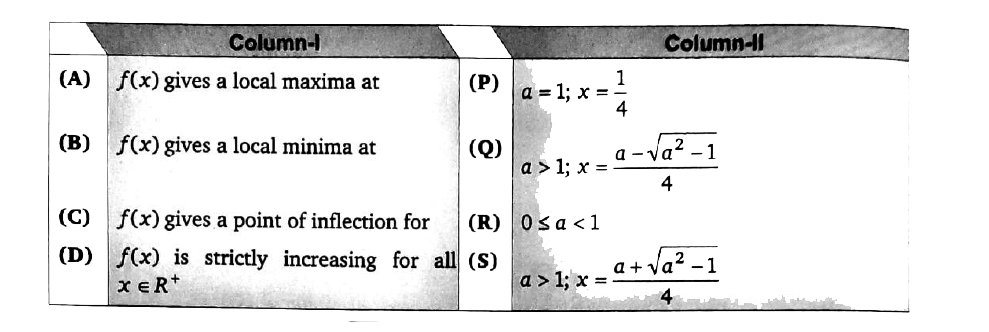Consider the functin f(x)=lnx8−ax+x2anda≥0 is a real constant :

The correct Answer is:Ato Q; BtoS; C toP; DtoR
Topper's Solved these Questions
- APPLICATION OF DERIVATIVES Book:VK JAISWALChapter:APPLICATION OF DERIVATIVES Exercise:EXERCISE (SUBJECTIVE TYPE PROBLEMS)
Explore 22 Videos
- APPLICATION OF DERIVATIVES Book:VK JAISWALChapter:APPLICATION OF DERIVATIVES Exercise:EXERCISE (COMPREHENSION TYPE PROBLEMS)
Explore 16 Videos
- AREA UNDER CURVESBook:VK JAISWALChapter:AREA UNDER CURVESExercise:EXERCISE (SUBJECTIVE TYPE PROBLEMS)
Explore 8 Videos
Similar Questions
Knowledge Check
The range of the functin f(x)=x+2|x+2| is
A{0,1}B{−1,1}CRDR−{−2}The inverse of the function f(x)=loga(x+√x2+1)(a≥0,a≠1) is
A12(ax−a−x)Bnot defined for all xCdefined for xgt0Dnone of these
A x=0 the given function f(x)={xsin(logx2);x≠0and0;x=0 is
View SolutionA real-valued functin f(x) satisfies the functional equation f(x−y)=f(x)f(y)−f(a−x)f(a+y), where a given constant and f(0)=1. Then prove that f(x) is symmetrical about point (a, 0).
View SolutionA real-valued functin f(x) satisfies the functional equation f(x−y)=f(x)f(y)−f(a−x)f(a+y), where a given constant and f(0)=1. Then prove that f(x) is symmetrical about point (a, 0).
View SolutionConsider the quadratic function f(x)=ax2+bx+c where a,b,c∈R and a≠0, such that f(x)=f(2−x) for all real number x. The sum of the roots of f(x) is
View SolutionThe number of real values of 'a' for which the largest value of the functin f(x)=x2+ax+2 in the interval [−2,4] is 6 will be :
View SolutionThe number of real values of 'a' for which the largest value of the functin f(x)=x2+ax+2 in the interval [−2,4] is 6 will be :
View Solution
